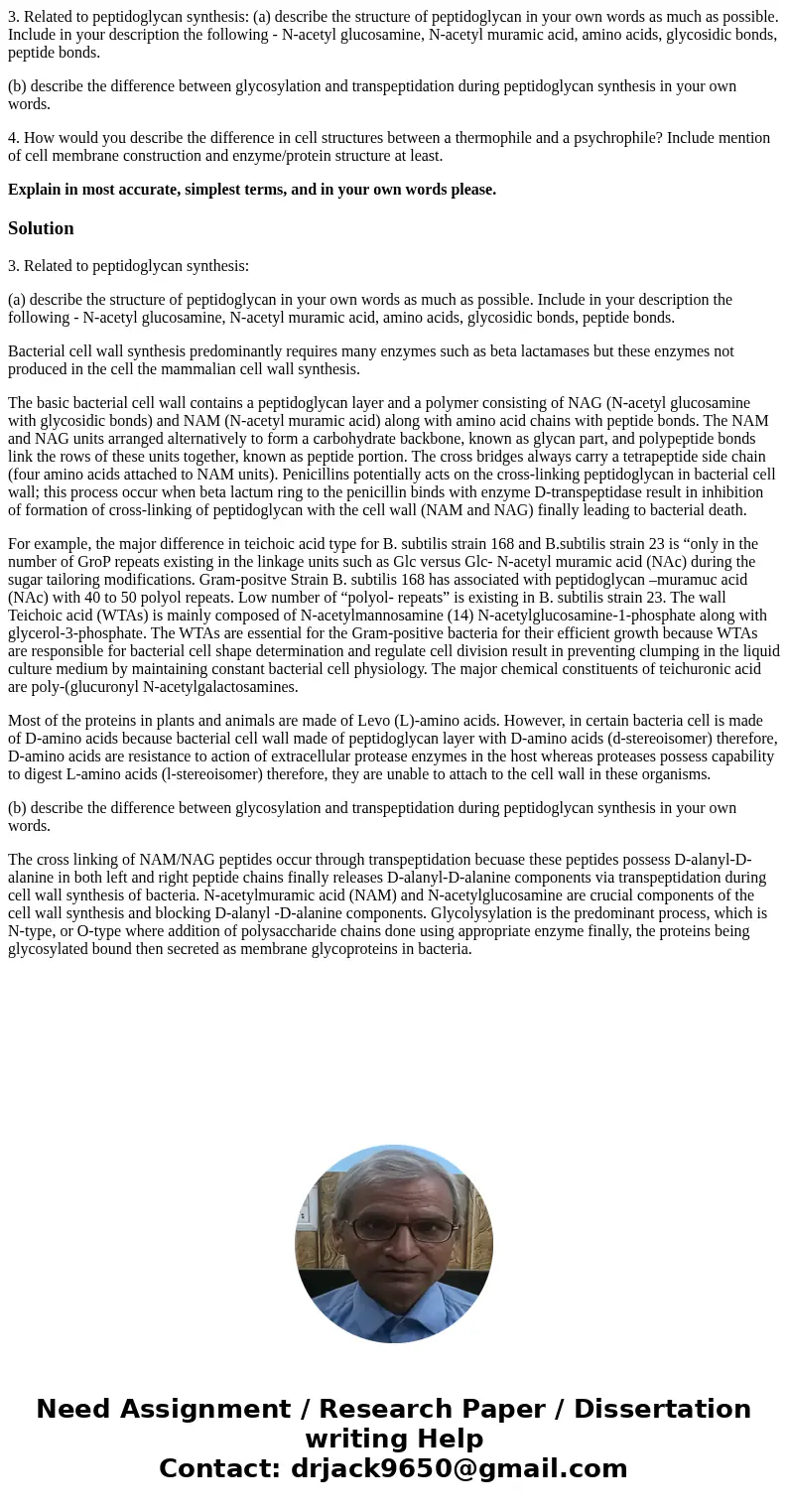3 Related to peptidoglycan synthesis a describe the structur
3. Related to peptidoglycan synthesis: (a) describe the structure of peptidoglycan in your own words as much as possible. Include in your description the following - N-acetyl glucosamine, N-acetyl muramic acid, amino acids, glycosidic bonds, peptide bonds.
(b) describe the difference between glycosylation and transpeptidation during peptidoglycan synthesis in your own words.
4. How would you describe the difference in cell structures between a thermophile and a psychrophile? Include mention of cell membrane construction and enzyme/protein structure at least.
Explain in most accurate, simplest terms, and in your own words please.
Solution
3. Related to peptidoglycan synthesis:
(a) describe the structure of peptidoglycan in your own words as much as possible. Include in your description the following - N-acetyl glucosamine, N-acetyl muramic acid, amino acids, glycosidic bonds, peptide bonds.
Bacterial cell wall synthesis predominantly requires many enzymes such as beta lactamases but these enzymes not produced in the cell the mammalian cell wall synthesis.
The basic bacterial cell wall contains a peptidoglycan layer and a polymer consisting of NAG (N-acetyl glucosamine with glycosidic bonds) and NAM (N-acetyl muramic acid) along with amino acid chains with peptide bonds. The NAM and NAG units arranged alternatively to form a carbohydrate backbone, known as glycan part, and polypeptide bonds link the rows of these units together, known as peptide portion. The cross bridges always carry a tetrapeptide side chain (four amino acids attached to NAM units). Penicillins potentially acts on the cross-linking peptidoglycan in bacterial cell wall; this process occur when beta lactum ring to the penicillin binds with enzyme D-transpeptidase result in inhibition of formation of cross-linking of peptidoglycan with the cell wall (NAM and NAG) finally leading to bacterial death.
For example, the major difference in teichoic acid type for B. subtilis strain 168 and B.subtilis strain 23 is “only in the number of GroP repeats existing in the linkage units such as Glc versus Glc- N-acetyl muramic acid (NAc) during the sugar tailoring modifications. Gram-positve Strain B. subtilis 168 has associated with peptidoglycan –muramuc acid (NAc) with 40 to 50 polyol repeats. Low number of “polyol- repeats” is existing in B. subtilis strain 23. The wall Teichoic acid (WTAs) is mainly composed of N-acetylmannosamine (14) N-acetylglucosamine-1-phosphate along with glycerol-3-phosphate. The WTAs are essential for the Gram-positive bacteria for their efficient growth because WTAs are responsible for bacterial cell shape determination and regulate cell division result in preventing clumping in the liquid culture medium by maintaining constant bacterial cell physiology. The major chemical constituents of teichuronic acid are poly-(glucuronyl N-acetylgalactosamines.
Most of the proteins in plants and animals are made of Levo (L)-amino acids. However, in certain bacteria cell is made of D-amino acids because bacterial cell wall made of peptidoglycan layer with D-amino acids (d-stereoisomer) therefore, D-amino acids are resistance to action of extracellular protease enzymes in the host whereas proteases possess capability to digest L-amino acids (l-stereoisomer) therefore, they are unable to attach to the cell wall in these organisms.
(b) describe the difference between glycosylation and transpeptidation during peptidoglycan synthesis in your own words.
The cross linking of NAM/NAG peptides occur through transpeptidation becuase these peptides possess D-alanyl-D-alanine in both left and right peptide chains finally releases D-alanyl-D-alanine components via transpeptidation during cell wall synthesis of bacteria. N-acetylmuramic acid (NAM) and N-acetylglucosamine are crucial components of the cell wall synthesis and blocking D-alanyl -D-alanine components. Glycolysylation is the predominant process, which is N-type, or O-type where addition of polysaccharide chains done using appropriate enzyme finally, the proteins being glycosylated bound then secreted as membrane glycoproteins in bacteria.

 Homework Sourse
Homework Sourse